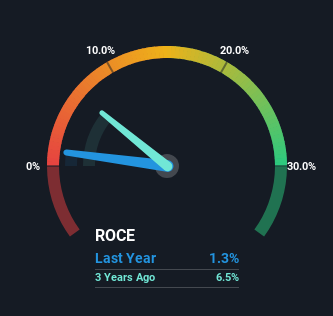- Japan
- /
- Basic Materials
- /
- TSE:5232
Sumitomo Osaka Cement (TSE:5232) Has Some Difficulty Using Its Capital Effectively
If you're looking at a mature business that's past the growth phase, what are some of the underlying trends that pop up? A business that's potentially in decline often shows two trends, a return on capital employed (ROCE) that's declining, and a base of capital employed that's also declining. This combination can tell you that not only is the company investing less, it's earning less on what it does invest. In light of that, from a first glance at Sumitomo Osaka Cement (TSE:5232), we've spotted some signs that it could be struggling, so let's investigate.
Understanding Return On Capital Employed (ROCE)
Just to clarify if you're unsure, ROCE is a metric for evaluating how much pre-tax income (in percentage terms) a company earns on the capital invested in its business. To calculate this metric for Sumitomo Osaka Cement, this is the formula:
Return on Capital Employed = Earnings Before Interest and Tax (EBIT) ÷ (Total Assets - Current Liabilities)
0.013 = JP¥3.4b ÷ (JP¥356b - JP¥93b) (Based on the trailing twelve months to December 2023).
So, Sumitomo Osaka Cement has an ROCE of 1.3%. In absolute terms, that's a low return and it also under-performs the Basic Materials industry average of 8.8%.
View our latest analysis for Sumitomo Osaka Cement

Above you can see how the current ROCE for Sumitomo Osaka Cement compares to its prior returns on capital, but there's only so much you can tell from the past. If you'd like to see what analysts are forecasting going forward, you should check out our free analyst report for Sumitomo Osaka Cement .
So How Is Sumitomo Osaka Cement's ROCE Trending?
There is reason to be cautious about Sumitomo Osaka Cement, given the returns are trending downwards. To be more specific, the ROCE was 6.3% five years ago, but since then it has dropped noticeably. On top of that, it's worth noting that the amount of capital employed within the business has remained relatively steady. Companies that exhibit these attributes tend to not be shrinking, but they can be mature and facing pressure on their margins from competition. So because these trends aren't typically conducive to creating a multi-bagger, we wouldn't hold our breath on Sumitomo Osaka Cement becoming one if things continue as they have.
Our Take On Sumitomo Osaka Cement's ROCE
In summary, it's unfortunate that Sumitomo Osaka Cement is generating lower returns from the same amount of capital. Despite the concerning underlying trends, the stock has actually gained 2.3% over the last five years, so it might be that the investors are expecting the trends to reverse. Regardless, we don't like the trends as they are and if they persist, we think you might find better investments elsewhere.
On a separate note, we've found 2 warning signs for Sumitomo Osaka Cement you'll probably want to know about.
If you want to search for solid companies with great earnings, check out this free list of companies with good balance sheets and impressive returns on equity.
New: Manage All Your Stock Portfolios in One Place
We've created the ultimate portfolio companion for stock investors, and it's free.
• Connect an unlimited number of Portfolios and see your total in one currency
• Be alerted to new Warning Signs or Risks via email or mobile
• Track the Fair Value of your stocks
Have feedback on this article? Concerned about the content? Get in touch with us directly. Alternatively, email editorial-team (at) simplywallst.com.
This article by Simply Wall St is general in nature. We provide commentary based on historical data and analyst forecasts only using an unbiased methodology and our articles are not intended to be financial advice. It does not constitute a recommendation to buy or sell any stock, and does not take account of your objectives, or your financial situation. We aim to bring you long-term focused analysis driven by fundamental data. Note that our analysis may not factor in the latest price-sensitive company announcements or qualitative material. Simply Wall St has no position in any stocks mentioned.
About TSE:5232
Sumitomo Osaka Cement
Engages in the cement business in Japan and internationally.
Excellent balance sheet second-rate dividend payer.
Similar Companies
Market Insights
Community Narratives



